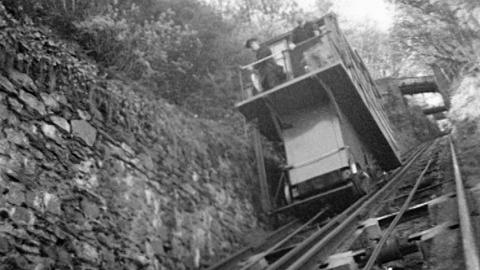The South West Film and Television Archive (SWFTA) is the regional film archive for the South West of England. Established in 1993, SWFTA's core collection comprises of the combined programme libraries of Westward Television and TSW (Television South West). The archive also cares for a significant number of donated film collections, both amateur and professional, dating back to the early 1900s.
This film is part of Free

The Lynton and Lynmouth Cliff Valley Railway
Victorian lift offers water-powered ups and downs.
From the collection of:

Overview
TV reporter Clive Gunnell is on the Lynton and Lynmouth Cliff Railway in North Devon. The water-powered funicular railway is unique and run using water from the nearby River Lyn and travelling up and down between Lynton five hundred feet up on the top of the cliff and the harbour village of Lynmouth. The two cable cars use gravity and water tanks to move up and down. The lift displaces water only if its needs to becuase it is also dependent on the weight of its passengers!
Fortuitously enshrined in law is the right to refill the water tanks because the lift works on a total loss system whereby water is released and not reused. The railway began operating by 1890 and was designed by engineer and follower of Brunel, George Croyden Marks and paid for largely by the publisher Sir George Newnes, in part responsible for introducing popular journalism.The picturesque coastline became popular in Georgian and Victorian times when paddle steamers arrived from Bristol and South Wales and the area retains much of its latter day charm. In 1952 torrential rain caused the West and East Lyn rivers to break their banks and twenty-eight lives were lost at Lynmouth and Barbrook.
Related

Lynton and Lynmouth Holiday Lynton and Lynmouth Holiday
Home movie 1935 10 mins Silent Location: Lynton
Political uncertainty at home and abroad roots holidays at home.

John Doyle in Lynton and Lynmouth John Doyle in Lynton and Lynmouth
News 1971 5 mins Location: Lynton
John Doyle is in this special report on the summer season and arrives in Lynton and Lynmouth.

Lynton and Lynmouth Lynton and Lynmouth
1921 12 mins Silent Location: Lynton
Could these holidaymakers have imagined the violent potential of an idyllic Devon landscape?

The Lynton Light Railway The Lynton Light Railway
Amateur film 1935 5 mins Silent Location: Lynton
A trip from Exeter to see the Lynton Light Railway in the year of its closure

Lynmouth Floods' Anniversary Lynmouth Floods' Anniversary
News 1977 5 mins Location: Lynton
The 25th Anniversary of the Lynton and Lynmouth Flood

British Deaf Association Summer School, Exeter (1957) British Deaf Association Summer School, Exeter (1957)
Non-Governmental Organisations sponsored film 1957 25 mins Silent Location: Exeter
A trip up Lynton & Lynmouth’s stunning water-powered railway is one of the highlights the British Deaf Association’s trip to Exeter in the 1950s.

All We Imagine As Light - Exclusive Q&A All We Imagine As Light - Exclusive Q&A
Short interview 2025 28 mins
Payal Kapadia discusses her Cannes prize-winning and Bafta-nominated drama with Ashanti Omkar.

Khichdi Khichdi
Animation & Artists Moving Image 2023 16 mins
The interwoven stories of four best friends who reunite in the UK, thirty-five years after training together as nurses during their teens in Ferozepur, Punjab.

Dr XYZ: A Medical Drag Transthology Dr XYZ: A Medical Drag Transthology
Documentary 2023 15 mins
A satirical take on the healthcare service announcements of the 1960s and 70s.

Every Moment Counts Every Moment Counts
Animation & Artists Moving Image 2023 9 mins
A short animation that offers a window into the world of children’s palliative care.

Police Story: Panel Discussion Police Story: Panel Discussion
Inside Film 2024 24 mins
Panel discussion on Jackie Chan's 1985 action classic Police Story, with Chase Armitage, Sam Mak and Jadey Duffield.

China O'Brien: The Reunion China O'Brien: The Reunion
Documentary 2024 60 mins
Cynthia Rothrock, Richard Norton and Keith Cooke reunite three decades on from the groundbreaking martial arts classic.